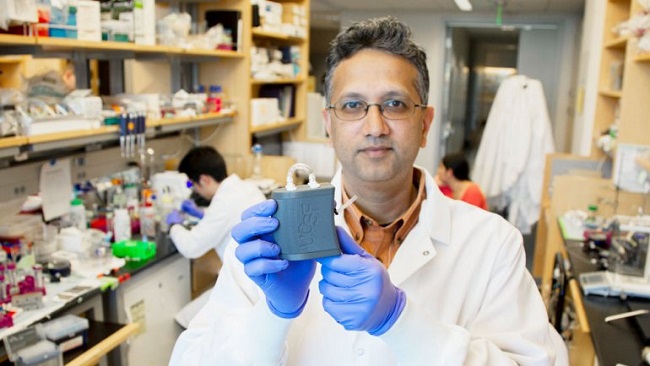Latest News and Details Of the Incredible Bio-Artificial Kidney That Can Treat Renal Failure And End Dialysis Completely
In August last year we bought you a story about one of the most incredible advances in medical technology. That was the artificial kidney project where a professor and a doctor teamed up together to invent a gadget with the potential of saving millions of lives. The device an artificial kidney was devised as a substitute for a human kidney and has been built to function in place of kidneys gone bad.
 Image Source: www.futurescope.co
Image Source: www.futurescope.co
Advertisement
The kidney project was conceived as a brainchild of Dr Professor Shuvro Roy in 2010. It is a national research project which created a free standing bioartifical kidney that could be used in the treatment of end stage renal disease or simply kidney failure. The device no bigger than a coffee cup would be surgically implanted into a patient and provide then with a long term solution for kidney transplants ending the expensive and harrowing process of dialysis which had just short term effects. The bioartificial kidney when implemented will be saving health care millions of dollars.
 Image Source: www.ucsf.edu
Image Source: www.ucsf.edu
The amazing duo responsible for this project is Professor Shuvro Roy PhD and project technical director and Doctor William Fissell M.D. The home base of the project is UCSF (University of California San Francisco) however smaller teams coordinate with the project and are based in various universities across the country.
 Image Source: www.linkedin.com
Image Source: www.linkedin.com
 Image Source: foryourkidney.com
Image Source: foryourkidney.com
 Image Source: www.mercurynews.com
Image Source: www.mercurynews.com
 Image Source: www.telegraphindia.com
Image Source: www.telegraphindia.com
 Image Source: www.mayoclinic.org
Image Source: www.mayoclinic.org
 Image Source: www.youtube.com
Image Source: www.youtube.com
 Image Source: www.telegraphindia.com
Image Source: www.telegraphindia.com
 Image Source: study.com
Image Source: study.com
 Image Source: study.com
Image Source: study.com
 Image Source: www.kidneybuzz.com
Image Source: www.kidneybuzz.com

Image Source: anatomychartee.co
1The bioartificial kidney can save millions of lives waiting for kidney transplants
According to the National Kidney Foundation more than 100, 791 people were awaiting a kidney transplant in 2016 alone. 3000 are added to that list every month. If the kidney project now underway meets its new deadline for human clinical trials and becomes available for patients, it will be the biggest milestone in medical history ending suffering for millions of people on dialysis saving billions in the bargain. Image Source: www.futurescope.co
Image Source: www.futurescope.co
2What is the kidney project?
 Image Source: www.ucsf.edu
Image Source: www.ucsf.edu
3The men responsible for the kidney project
 Image Source: www.linkedin.com
Image Source: www.linkedin.com
4What is the device all about?
The bioartificial kidney is a two part device. Using the advancements in silicon nanotechnology, membrane filtration and cell science, the device is powered by a patient’s blood pressure and does not even need external tubes, tethers and immunosuppressant drugs. The bioartificial kidney is a miniature version of the larger extracorporeal Renal Assist Device (RAD) that consists of a membrane hemofilter and bioreactor consisting of tubule cells that can mimic most of the metabolic, endocrine and immunological functions of a real human kidney. In short, it is a mechanical kidney. The kidney project has applied microelectromehcnical systems and nanotechnology to recreate the large and expensive RAD into a miniature bioartificial kidney that self monitors and regulates itself. It requires just one surgery to establish a permanent blood connection with the patient. Once it does so, the device will process blood continuously 24 hours a day eliminating the need for dialysis. Image Source: foryourkidney.com
Image Source: foryourkidney.com
5The technology that it uses
In order to mimic a real kidney, the device contains ultrafiltration membranes that work efficiently to regulate blood flow. It will also stabilize necessary cells working in an engineered environment. The key technologies at work in the bioartificial kidney are- High-efficiency ultrafiltration membranes
- Maintaining blood interactions like thrombosis and fouling
- Stabilized differentiated function of renal cells in an engineered environment
- Silicon nanotechnology for robust compact membranes
- Improved molecular coatings for efficient blood compatibility
- Techniques to coat silicon membranes without blocking pores
- Cell sourcing and storage
- Stable differentiated function of renal cells in an engineered construct
 Image Source: www.mercurynews.com
Image Source: www.mercurynews.com
6The components hemofilter and bioreactor
All of the above technology is firmly in place. The hemofilter uses the body’s blood pressure to enable the filtration process without any pump or power supply. That’s the incredible feature of the device. The hemofilter is capable of generating volumes of ultrafiltration at a pressure similar to capillary perfusion pressure or the normal pressure at which blood circulates to organs in our bodies. The device will also remain free of fouling and keep protein losses at a minimum in continuous implantable therapy. The bioreactor features the latest technology in tissue engineering to grow renal tubule cells. It will be made capable of reabsorption of high volumes of salt and water from the ultrfiltrate while remaining a firm barrier to reabsorption of toxins. It will also facilitate autoregulation of blood and produce vitamin D in the body. Image Source: www.telegraphindia.com
Image Source: www.telegraphindia.com
7Summarized version of how the bioartifical kidney works
The hemofilter module will process incoming blood to create a watery ultrafiltrate which contains sugars, salts and dissolved toxins. The bioreactor consisting of kidney cells processes the ultrafiltrate and then returns the sugar and salt back into the blood. Water is then reabsorbed back into the body in this process which also concentrates the ultrafiltrate into urine that is then sent to the bladder for elimination. This means it works exactly like a human kidney. Image Source: www.mayoclinic.org
Image Source: www.mayoclinic.org
8The latest clinical trial news
Preclinical testing is already underway for the bioreactor while pre-trials for the hemofilter have been completed. The latest statement by the kidney project on its Facebook pagereads “Results from preclinical testing of the Hemofilter are encouraging. We have successfully implanted the Hemofilter component into large animal models for up to 1 month. The animals responded well, without serious complications. We have collected enough preclinical data to apply for our first clinical trial and are waiting for approval for our first application.” Image Source: www.youtube.com
Image Source: www.youtube.com
9Human implantation trials by late 2018
The kidney project team is seeking to progress to full device implantation in humans by late 2018. After all trials are over, the device will be made available to public where the final stage of human clinical trials is expected to finish by 2020. This depends on funding and no unexpected drawbacks. Image Source: www.telegraphindia.com
Image Source: www.telegraphindia.com
10Where will the clinical trials take place?
According to the Kidney project, clinical trials will take place throughout the United States and will not be divulged till full approval is granted. However, the first trial will most probably be in San Francisco, CA or Nashville where the main Kidney project teams are based. The team says that if funding targets are met, then trials will be fully funded. Trials will only be available after the first pre trials are over. Image Source: study.com
Image Source: study.com
11Challenges being faced by the kidney project
As of now, the biggest challenge is funding. On its project page, it has mentioned that funding is the single largest hurdle in the path of completing pre-clinical trials for both the components. The completion of pre-clinical trials will enable the team to produce prototypes for the preliminary round of human studies. The long-term challenge is observing a trouble-free operation of the device beyond a few months after surgical implantation.Only preclinical studies will yield enough data and information about problems if any. Meet the kidney project team below Image Source: study.com
Image Source: study.com
12Project Coordinator completes Appalachian Trail to raise $ 7591
In a dramatic bid to acquire funds for the project, the ex-coordinator Stephanie Brummet even took to hiking through the entire Appalachian trail completing a trek of 2,190 miles from March to September hiking from Georgia to Maine. Stephanie dedicated her hike for the Kidney Project and started a crowdfund for the duration of the trail. Along with contributions, Stephanie collected $7,591 which will be used for the continued development of the Bioreactor. Image Source: www.kidneybuzz.com
Image Source: www.kidneybuzz.com
13Applications for human trials.
The kidney project is also accepting applications for clinical testing although it doesn’t guarantee participation. The patient selection team has been entrusted with the task of human clinical trials. The kidney project needs as much awareness and support for it to be a success and get underway by 2020. Share the article to generate awareness of this remarkable feat of medical technology
Image Source: anatomychartee.co



When do you think it will be available in the USA... I could use it now
ReplyDelete